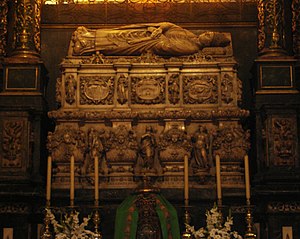Saint Olegarius
| Saint Olegarius | |
|---|---|

Sepulcher of Saint Olegarius, side chapel of Christ of Lepanto, Cathedral of Barcelona.
|
|
| Born | 1060 Barcelona |
| Died | 6 March 1137 |
| Venerated in | Roman Catholic Church |
| Canonized | 1675 |
| Major shrine | side chapel of Christ of Lepanto, Cathedral of Barcelona |
| Feast | 6 March |
Saint Olegarius Bonestruga (from Germanic Oldegar, Latin: Ollegarius, Oligarius, Catalan: Oleguer, Spanish: Olegario; 1060 – 6 March 1137) was the Bishop of Barcelona from 1116 and Archbishop of Tarragona from 1118 until his death. He was an intimate of Ramon Berenguer III, Count of Barcelona, and often accompanied the count on military ventures.
Olegarius was canonised in 1675 and his major shrine and sepulchre is in the side chapel of Christ of Lepanto in the cathedral of Barcelona. His feast is celebrated the date of his death: 6 March. An unreliable vita was composed for his canonisation, based on a fourteenth-century Vitae sancti Ollegarii, which is based on a lost twelfth-century vita often ascribed to Olegarius' contemporary of Barcelona, Renald the Grammarian.
Olegarius was born to a noble family of Barcelona. His father was a follower of Ramon Berenguer I, Count of Barcelona; his mother was Giulia. At the age of ten, Olegarius entered the guild of canon priests of the Cathedral of Barcelona. He later served as superior (provost) of the canonries of Barcelona and then Sant Adrià de Besós (1095–1108), and later as abbot of the Augustinian monastery of Saint-Ruf (Saint Rufus) in Avignon (1113–1118). As abbot of Saint-Ruf, Olegarius had mediated the Mediterranean alliance between the Republic of Pisa, Kingdom of Cagliari, County of Provence, and Barcelona against the Almoravid pirates based on the Balearic Islands, resulting in the expedition of 1113–15. In the Gesta triumphalla per Pisanos, facta de captione Hierusalem et civitatis Mayoricarum of the Pisan deacon Enric (not, as sometimes alleged, Lorenzo Verones), Olegarius names is misspelled Nogelarius or Nigelarius.
...
Wikipedia
